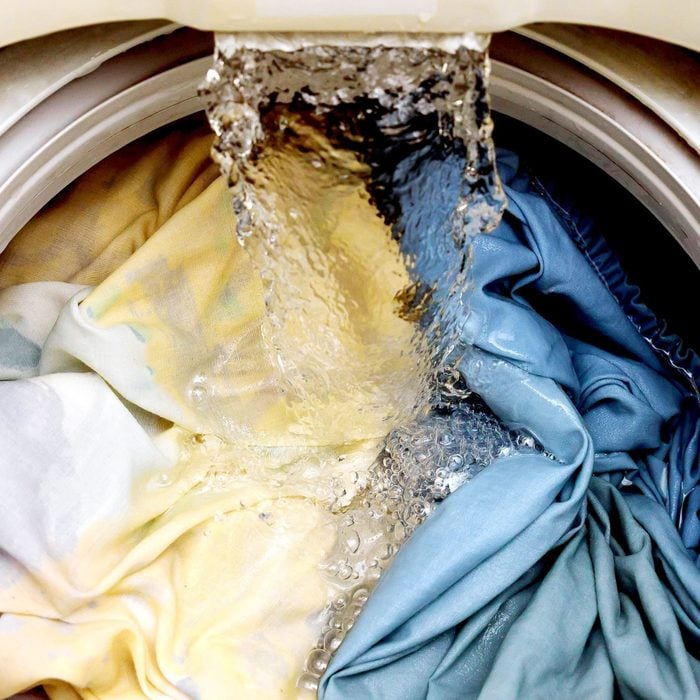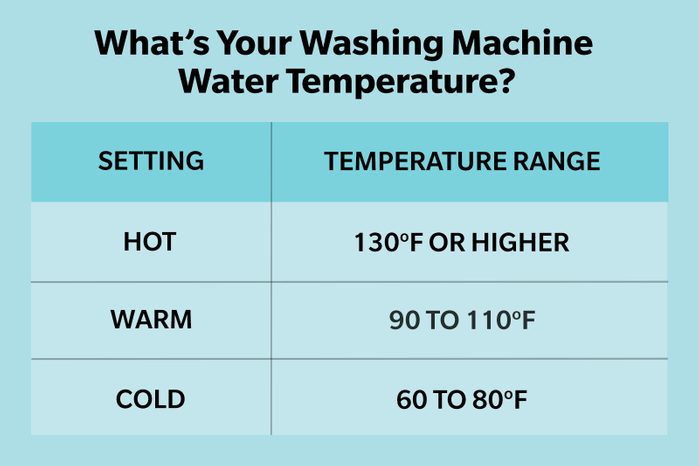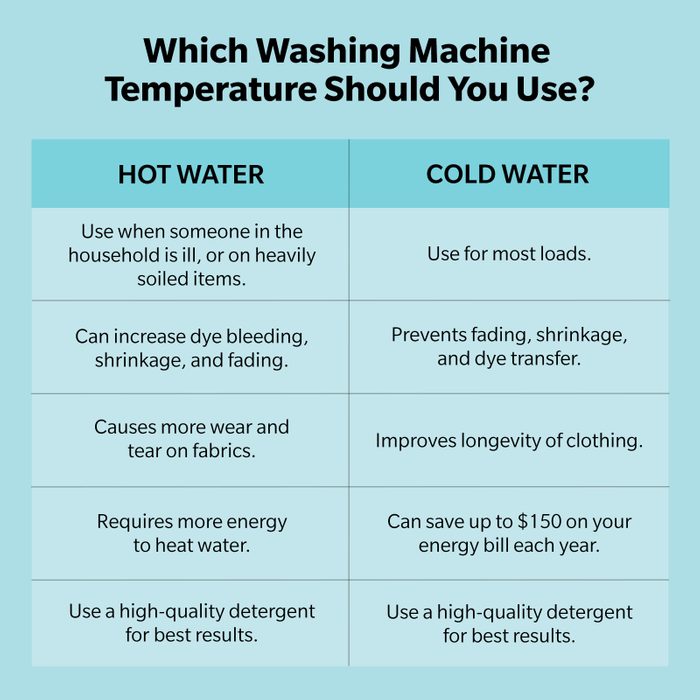How to Choose the Best Washing Machine Temperature for Your Clothes
Updated: Dec. 21, 2023

Switch most loads to this expert-recommended washing machine water temperature, and you could save up to $150 a year.
There are many factors to consider when determining how to do laundry the right way: What’s the best laundry detergent? Should you use fabric softener? And what do your garments’ laundry symbols indicate about the best washing method? What temperature to wash clothes is another decision you need to make, and it’s one that often confuses people.
In the past, using hot water was the best way to get clothes clean because detergents weren’t as effective as they are today, explains Jessica Zinna, PhD, a senior scientist with Tide. As technology has advanced, so have the requirements for washing clothes. “Laundry detergents have improved, washing machines have advanced cleaning capabilities, and new fabric types have become popular,” she says. “These changes allow for the use of cold water to achieve a deep clean on your clothes.”
So if both hot and cold water clean items well, how do you know what temperature to wash clothes? Read on for everything you need to know about setting your washing machine temp.
Get The Healthy @Reader’s Digest newsletter
When to use hot water
The first thing you should always do when figuring out what temperature to wash clothes is refer to the specific care label on your garment to see if it can be safely washed in hot water, says Zinna.
Many people use hot water for their laundry because they believe it gets clothes cleaner and whiter clothes brighter. “As anyone knows from trying to clean dirty dishes in cold water, it’s easier to clean in hot water than it is in cold water because cleaning ingredients are more active given the higher thermal energy of hot water,” she says.
But while hot water cleans efficiently, it can also shrink your clothes, cause fading, and lead to dye transfer, which can make your garments look older faster. It also requires more energy. “Up to 90 percent of the energy used during the laundry process goes toward heating the wash water for warm or hot cycles,” Zinna explains.
There are situations in which using warm or hot water is important, “like when a member of the household is ill, or for heavily soiled garments like cloth diapers, sheets, and workout clothing,” she says. Hot water is also best if anyone in the household is suspected or confirmed of having COVID-19, and laundry guidelines from the Centers for Disease Control and Prevention specify the appropriate water settings to use. In that case, wash your sheets, pillowcases, clothing—you name it—in hot water.
What New York’s Laundry Detergent Ban Means for Some Popular Brands
Pros of hot water:
- Good for cleaning heavily soiled clothes
- Smartest option when a member of the household is sick
- Necessary when a member of the household has COVID-19
Cons of hot water:
- May shrink clothes
- Can lead to fading and/or dye transfer
- Uses more energy
To remove all of the built-up residue from your clothes before washing, try laundry stripping.
How Often Should You Wash Your Sheets? Here’s What Germ Experts Recommend
When to use warm water
Many people opt to use warm water for most of their laundry. Happy medium, right? Well, not exactly. It often isn’t the best option. “Warm water, though less damaging than hot water, can still cause shrinkage, fading, and dye transfer, which can prematurely age your garments,” Zinna explains.
To lower your risk of those laundry blunders, refer to the specific care label on your garment (prior to washing) to see if it can be safely laundered in warm water.
Though Zinna suggests washing most of your loads using cold water, she admits warm water is useful when someone is ill or items are heavily soiled. For instance, that’s how to wash towels that are stained with grease from your work in the garage.
Pros of warm water:
- Good for cleaning heavily soiled items
- Good option when a member of the household is sick
Cons of warm water:
- May shrink clothes
- Can lead to fading and/or dye transfer
Here’s How Often You Should Really Wash Your Towels
When to use cold water
A lot of people grew up thinking cold laundry was made of darks, while hot laundry was full of whites. In reality, you should use cold water for most of your loads “because it provides an effective clean, is more sustainable, and improves the longevity of your clothes by preventing wear and tear,” explains Zinna.
If you’re ever doubting what temperature to wash clothes or are laundering clothes without care labels, cold water is your best bet for preventing damage, including shrinkage and fading. Yes, that’s even how to wash whites to keep them bright. There’s one important caveat, however: You should check to see that the cold water in your washing machine is in the range of 60 to 80 degrees Fahrenheit (read on to learn how to do that). If your washing machine runs cold, it’s possible that some detergents won’t be as effective or rinse out completely.
Washing your clothes in cold water is also the most energy-efficient option. If you’re interested in washing in cold water to help preserve clothes, save energy, and save money on your energy bill (up to $150 a year!), Zinna suggests using a specially formulated detergent, like Tide Hygienic Clean Heavy Duty 10X Power Pods. “They are a great option because they are formulated with enzymes and surfactants specially designed to provide superior cleaning in cold water,” she says. Another great pick: Persil ProClean Liquid Laundry Detergent.
Keep in mind that you can always wash garments whose care label specifies warm water in cold water instead. “The rule of thumb is that you can always go down in recommended temperature but should not go up in temperature,” Zinna notes.
She also debunks the myth that your clothes will shrink at 40 degrees, adding that washing in cold water will instead prevent shrinkage. “You should always check the care labels on garments, though, because some delicate garments, like sweaters or dry-clean-only items, should not be washed in water, regardless of the temperature,” she says. By washing in cold water, you can save yourself the step of learning to unshrink clothes.
Pros of cold water:
- Most energy-efficient option
- Won’t shrink or fade clothing.
- Prolongs clothing’s life
- Saves you money on energy
Cons of cold water:
- Less effective for heavily soiled items
- Doesn’t sanitize clothes
Here’s How to Get the Sweat Smell Out of Workout Clothes
What are the differences in water temperature?
The exact range of your water temperature can vary by manufacturer. “Refer to your user manual or appliance manufacturer for exact ranges if desired,” Zinna says.
That said, she offered the following temperature ranges for the three washing machine settings:

How do I know if the temperature settings on my washing machine are correct?
The following tips work for both traditional and HE washers. To check the temperature of your top-load washing machine water, Zinna suggests the following steps:
-
Turn your washing machine on to the desired temperature setting, such as hot or cold.
-
Hold a candy thermometer under the water stream as it comes out of your machine. Check the washing machine temperature to see if the water is within the range for your desired setting.
-
If the water temperature is not in range, contact a licensed service technician or the appliance manufacturer to troubleshoot.
For front-loading machines, there is not a straightforward way to test your water temperature at home, Zinna notes. “Contact a licensed service technician or the appliance manufacturer to troubleshoot if you are concerned about your water temperatures,” she says.
Research: 9 Sneaky Things You Touch Every Day That Could Be Toxic
Refer to the chart below to determine the best water temperature to use for your laundry load:

